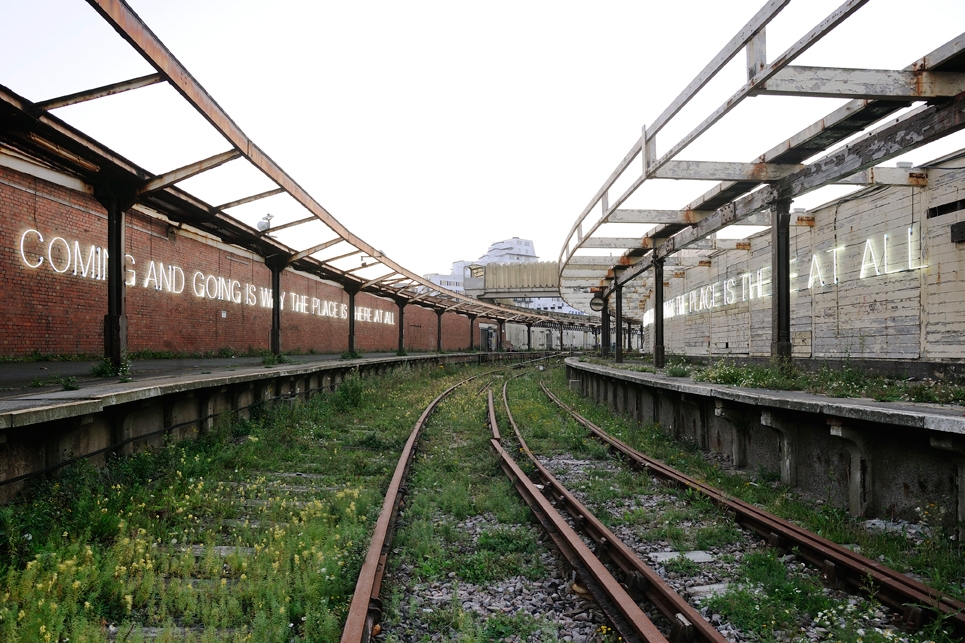Every three years, down on the coast in Kent, the Folkestone Triennial attracts a growing number of visitors to enjoy the seaside while discovering site-specific art commissions — some temporary, some that will become permanent — which revive a city that used to be a prosperous fashionable coastal resort up to the 1970s before losing its appeal to holidaymakers in favour of increasingly accessible foreign destinations, severely damaging its tourist industry. The main initiative in the Creative Foundation’s wider plan for the city’s cultural regeneration, the Triennial is now in its third edition, this year curated by Lewis Biggs (the previous two being curated by Andrea Schlieker) and presents 20 new commissions around the theme ‘Lookout’, which successfully engages with the city’s past history, as well as with its present landscape and community.
The city’s vibrant past is commemorated even more poignantly by the extensive use of run-down and vacant buildings and structures by the artists, which convey a quite melancholic and nostalgic impression. Taking over the now disused, ghostly harbour railway station, Tim Etchells’ large neon installation hauntingly reads: ‘Coming and going is why the place is there at all’, recalling the once dense traffic that used to flow into the city, while questioning the relevance and future of a place that has lost its primary functions.
The city’s vibrant past is commemorated even more poignantly by the extensive use of run-down and vacant buildings and structures by the artists, conveying a quite melancholic and nostalgic impression
In a more intimate and personal manner, Emma Hart has taken residence in a derelict vacant apartment on top of a former frame makers’ shop, in which she has created a series of delicate yet disturbing ceramics that tackle the theme of ‘Lookout’ as a tension between our inner selves and outside world pressures. Arm-shaped sculptures seem to come out of the bedroom walls holding clip boards, creating a feeling of oppression, while hand-shaped ceramics are holding computer screens, on which collaged images mechanically pop in front of our eyes repeating messages such as ‘hey mate’ as if inviting us to rehearse lines for our public personas or digital avatars.
Open to many possibilities, this year’s theme has also given rise to less melancholic interpretations. Responding quite literally and not without humour, British artist Alex Hartley created a perch on a climbing platform hanging on top of the modernist mountain that is the Grand Burstin Hotel, creating an actual lookout point for a ‘vigil’. Inhabited by the artist and volunteers it can also function as a solitary meditative retreat, or a protestor’s base evoking recent Occupy movements.
Quite playful as well is Pablo Bronstein’s ‘monument to architecture’, for which he imagined what an 18th century English Baroque lighthouse would look like
Quite playful as well is Pablo Bronstein’s ‘monument to architecture’ as he calls it, for which he imagined what an 18th century English Baroque lighthouse would look like, in homage to the work of the iconic Baroque architect Nicholas Hawksmoor. With this quite monumental yet light-heartedly anachronistic lighthouse placed alongside and disrupting the uniform alignment of the existing row of multicoloured beach huts, Bronstein proposes to introduce a hint of folly in the architecture of leisure that constitutes the landscape of the South coast, while filling in a historical lack of Baroque architecture in the whole region.
Looking out for the future of the community, the redesign of Payers Park is the major commission of this Triennial, representing the biggest investment (£1.5 million). The East London-based bureau muf architecture/art took up the challenge to transform this tiny sloping patch of wasteland into a multi-functional and communal park, in which every feature has emerged from an active consultation with the local population, through a series of temporary workshops and events happening over the past year (for example a concert prompting the creation of a seating area, a silent disco inspiring a dance floor and a still operational archaeological dig).
Other artist projects, including a wind-powered elevator taking people up to the top of the Foord Road Viaduct viaduct by Marjetica Potrč and Ooze Architects, a fish & chips greenhouse by Something and Son and a series of water tower sculptures marking the hidden waterways of the river Pent Stream by Diane Dever and Jonathan Wright, guide you through the city and its seafront.
Stay on the look out also for the Triennial’s solid public events programme (note the two weekend conferences; Imagined Cities, on the relationship between art and architecture (11, 12 October) and The Sculpture Question, exploring the position of sculpture today (1, 2 November)), the growing Fringe exhibitions and events, and the Book Festival, taking place in November.
Online exclusive published 26 September 2014
